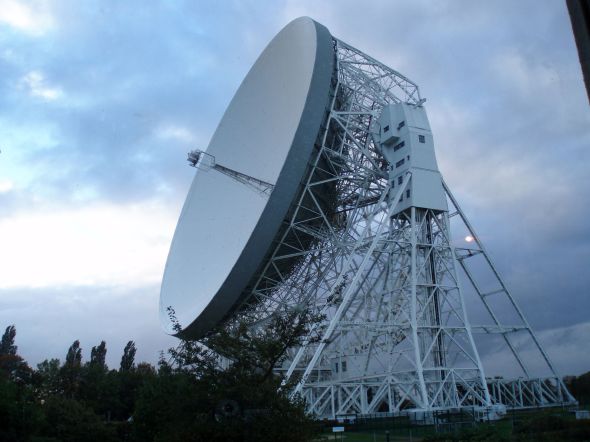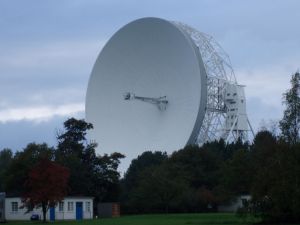Posted: August 25, 2009 | Author: Emma | Filed under: Uncategorized | Tags: galileo, Jodrell Bank, Lovell dish, telescope |
[tweetmeme only_single=false service=”wp.me” source=”allinthegutter”]
When I opened Google this morning it told me that today is the 400th anniversary of Galileo’s demonstration of his fancy new improved device for looking at faraway things – the telescope.**
I thought I should mark this in some way and I decided the best way to do so would be by talking about my favourite telescope, the Lovell Radio Telescope at Jodrell Bank in Manchester.

This is the Lovell. It doesn’t look much like the instrument Galileo demonstrated but it works on exactly the same principle: light (in this case in the form of radio waves) is collected and focused to make an image of some distant astronomical source. It is the third largest steerable radio dish in the world at 76.2 metres in diameter and it has been operating since it was completed in 1957. It’s construction was masterminded by Sir Bernard Lovell, back in the days when astronomers would turn up in a muddy field with a big box of wires and build their own detectors (it’s nothing like that now!)
I’ve used this telescope. At that time this meant going to visit it at Jodrell Bank to collect the images. I loved this; the office I was put in was right next to it so I could stare at it all day (not good for productivity) and I would walk around it at lunchtimes. I think the reason this is my favourite is the shear scale of it. It towers over you and can be seen for miles around. The whole thing is just such an impressive feat of engineering.
I think I’ll finish with two more pictures. This is it stowed i.e. not observing (it’s the safest position for it to be in case of high wind).

And this, with the building in the foreground, gives a good idea of what’s it’s like to stand by it and see it loom over you.

Does anyone else have a favourite?
** As has been pointed out in the comments by someone a lot more knowledgeable than me about these things, I should make it clear that Galileo didn’t invent the telescope himself. Also, Google apparently got the date wrong – see the comments for the full timeline!
Posted: August 17, 2009 | Author: Niall | Filed under: Uncategorized |
[tweetmeme only_single=false service=”wp.me” source=”allinthegutter”]
Ok so instead of writing a decent blog post, I’ve witten an ADS search plug-in for Firefox. For those of you who don’t know, ADS is the Astrophysics Data System run by the SAO and NASA. It contains listing and often links to pretty much every paper written on astrophysics.
Posted: August 7, 2009 | Author: Emma | Filed under: Uncategorized | Tags: close approach, hoax, mars |
[tweetmeme only_single=false service=”wp.me” source=”allinthegutter”]
Weareallinthegutter would like to make it clear that the planet Mars WILL NOT be coming ‘really close’ to Earth on 27th August and, even if it did, it WOULD NOT appear to be the size of the full moon. That would be bad. Really bad.
Full details available here
Posted: August 4, 2009 | Author: Emma | Filed under: Uncategorized | Tags: AD 536 event, comet, volcano |
[tweetmeme only_single=false service=”wp.me” source=”allinthegutter”]





In the year AD 536 something catastrophic happened which caused a drop in the global temperature lasting several years and led to widespread famine, and possibly plague outbreaks too. This is right in the middle of the Dark Ages – a time about which by definition we know very little – so how can we be so sure about this? Well, it turns out that when human records are sparse, tree records step in to fill the gap. The series of concentric rings in the trunk of a tree provide a history of its growth and, seeing as a new ring is made every year, its age. If a summer is a lot colder than normal then a tree has to conserve its energy and so forms a narrower ring than it would have if the weather had been better. This is exactly what’s seen in the tree ring record for nearly ten years, beginning in AD 536.
The historical record of this period isn’t completely Dark, and the surviving accounts provide a clue as to what could have caused the prolonged cold snap. The interestingly named Michael the Syrian wrote that “…the Sun was dark and its darkness lasted for eighteen months; each day it shone for about four hours, and still this light was only a feeble shadow” while someone called Lydus in Constantinople observed that “…the Sun became dim…for nearly a whole year…so that the fruits were killed”. There are also numerous Chinese references to obscured skies and summer frosts.
All of this points towards something in the atmosphere – a ‘dust veil’ – which blocked sunlight and cooled the planet. But what could have put a load of dust into the atmosphere? Here, things get more intriguing. The obvious culprit is the ash and sulphuric acid produced by an enormous volcanic eruption – a phenomenon known as a ‘volcanic winter’. 1816, the ‘Year Without a Summer’, is a more recent example of this, caused by the eruption of Mount Tambora in Indonesia. However, volcanic debris is easy to spot as it leaves a very recognisable acid layer trapped in an ice sheet in somewhere like Greenland. Therefore all we have to do is extract an ice core, figure out which bit of it corresponds to the sixth century and look for the layer. Simple. Unfortunately for this theory though, by the late 90s no convincing volcanic signature had been found……
The alternative, astronomical, scenario for the AD 536 dust veil is an asteroid or comet impact. No impact crater has ever been linked to this time period which points towards a mid-air explosion called an airburst. These release large amounts of energy in the form of a tree-flattening shockwave (as happened in Tunguska in 1908) and can also potentially trigger forest fires, which could in turn inject large quantities of soot into the atmosphere. This is where I get involved. Several years ago I was part of a group that tried to calculate how big a comet-triggered-fire would have to be to cause the observed cooling. It turned out that the answer to this is an area the size of Northern Europe which seems rather unlikely! Surely there would have been some record if this had happened? Clearly fires could have added to the cooling but they couldn’t have been the sole contributor. Comet impact plumes may provide the solution. When the comet airbursts, some energy from the explosion, along with the debris, is funneled back along the impact path causing a plume of material, which then falls back onto the top of the atmosphere and causes the dust veil. Case closed, right? As with most things in astronomy, it’s not that simple.
The comet impact theory looked to be the most likely explanation until early last year when Larsen et al. published a paper presenting new and improved ice core measurements. These finally showed a clear volcanic related acid signal for AD 536, larger than the one found for the Tambora eruption mentioned earlier.
This should be the end of the story. Indeed, until several hours ago when I started putting this together and happened to come across this abstract, I thought it was. Their tantalising, but still unpublished, detection of impact debris in the AD 536 layer of another ice core points back to the cometary culprit again. Without reading the full paper nothing’s certain, which means that the Larsen et al detected volcano is the best option for now!


Comet vs. volcano!
Larsen, L., Vinther, B., Briffa, K., Melvin, T., Clausen, H., Jones, P., Siggaard-Andersen, M., Hammer, C., Eronen, M., Grudd, H., Gunnarson, B., Hantemirov, R., Naurzbaev, M., & Nicolussi, K. (2008). New ice core evidence for a volcanic cause of the A.D. 536 dust veil Geophysical Research Letters, 35 (4) DOI: 10.1029/2007GL032450










